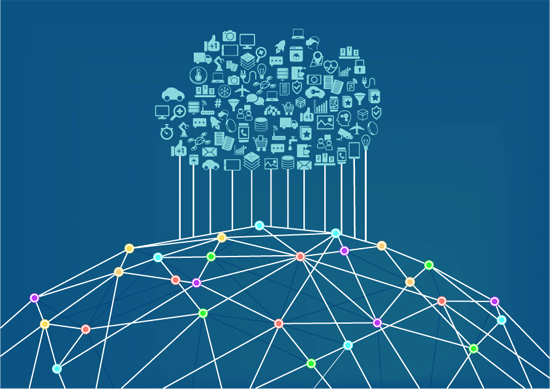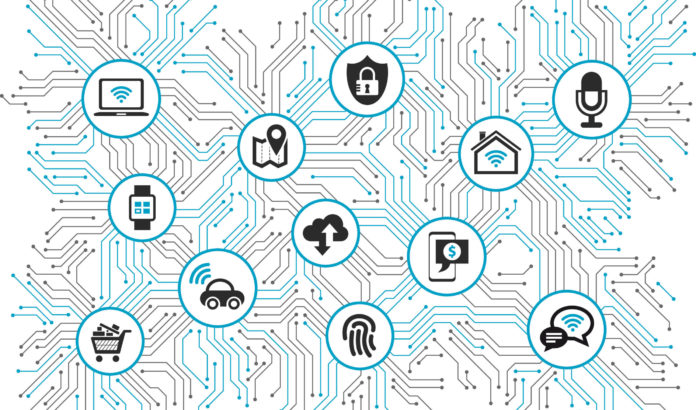18 Dec 2019
Internet of Things devices are flooding the everyday tech landscape. From smart voice assistants to in-store beacons, companies are constantly creating new ways to collect data and improve customer experiences.
Cloud-based data centers have been the primary tool for processing the massive influx of data from IoT devices. As more and more IoT devices are deployed, the need for faster and more reliable data processing has increased.
Cloud-based systems present an inherent latency as data traverses the Internet between IoT sensors and data processing centers. Recently, edge computing and fog computing architectures have been developed to fill that gap — to improve network efficiency and increase computing speed.
Edge and fog computing architectures also present new challenges for companies who are patenting computer-implemented technologies. Let’s take a look at how these computing architectures differ before we explore how they can affect patent strategies for tech companies.
WHAT IS CLOUD COMPUTING?

Cloud computing allows companies to store and process data across a network of shared computing systems, commonly known as the cloud. Amazon Web Services (AWS) and Google Cloud are just two of the major cloud platforms available today; there are many others.
You can think of the cloud as a huge, interconnected network of powerful servers that performs services for businesses and for people.
Cloud computing allows an end user to access a remote computer resource, such as software, a server or storage space, over the Internet. For example, Google Docs and Google Sheets are commonly used cloud-based document systems. They allow you to store your word-processing documents and spreadsheets online, edit them through a browser interface, share your documents and collaborate on them with other users over the Internet.
Other familiar software tools using cloud computing architectures include Microsoft Office 365, web-based email services like Gmail, Internet-based software-deployed services such as HubSpot and Salesforce, and popular content streaming services including Spotify, Pandora and Netflix.
However, centralized computing may not be suitable for many IoT devices that require faster data processing. This is where edge and fog computing come in.
WHAT IS EDGE COMPUTING?
Many IoT devices generate enormous amounts of data during operation. This has placed a strain on available networking bandwidth for smart devices that rely on the cloud.
But not all smart devices need cloud computing to function. Some data generated by IoT devices can be processed locally, for example, within the device that generated the data.
Edge computing enables data to be processed and analyzed closer to where the data was generated. This avoids the need to send all data over the Internet to a remote cloud computing system for processing. Edge computing technologies are increasingly being found in automated vehicles, mobile devices and home devices like Nest thermostats, Ring doorbells and even smart TVs.
The word “edge” relates to the geographic distribution of network resources. It generally refers to processing data near the edge of a network.
Instead of data traversing the Internet to a remote cloud-based system of servers , the computing infrastructure is now closer to the source, and data can be processed as close to its origin as possible.
Localizing data storage and processing places less strain on networks and communication resources, decreasing the time it takes to send data between the cloud and IoT devices, and mitigating bandwidth and latency issues.
WHAT IS FOG COMPUTING?
Fog and edge computing are actually similar in function. Both allow data to be processed and analyzed on platforms that are on or close to where the data came from. The main difference between edge and fog computing is where the processing of that data takes place.
Fog computing generally refers to the network connections that are found between edge devices and the cloud. Rather than deploying processes near the “edge” of a network, fog computing extends the cloud closer to the edge of the network.
As an example, certain computing services might be performed on a dedicated node or processor on your local network, enterprise network, network router (e.g., on the “Wireless Access Point” in your home) or network hub.
Moving closer to the network edge, such as within miles of the customer premises, can boost the performance of the network, enhance the reliability of services and reduce the cost of moving data computation to distant servers.
HOW THESE TECHNOLOGIES CAN AFFECT TECH PATENT STRATEGIES
Edge and fog computing will likely become more prevalent in the technology sector to address the inefficiencies and limitations of cloud computing.
Most modern software systems can be deployed through cloud, fog or edge computing. So if you’re a tech company, and you’re patenting technology that’s deployed through (or relies on) software, you need to be aware of how these technologies might affect your patent strategy.
Before the massive rise of cloud computing and IoT devices, the best practice for drafting software patent applications was to focus on an individual computer. The computer was typically either a server, such as an e-mail or web server, or a user terminal, such as a laptop or desktop computer running installed software, or possibly a smartphone.
But now that virtually all software can potentially be implemented via the cloud and/or an IoT device, the line blurs between what happens at the server and what happens at the user terminal.
To complicate things even more, cloud computing services have evolved into “serverless” architectures, which means nothing takes place on a single “server.” Fog and edge computing add another layer of complexity by further blurring the lines around where certain computing functionality is being performed. In short, any type of software process may be performed virtually anywhere in the world.
If you’re patenting software-implemented inventions that could be deployed through multiple modalities (cloud, fog and edge), you need to account for this when drafting your patent applications.
DRAFTING CLAIMS
One of the main challenges when drafting claims for IoT technology is often the issue of divided infringement. Ideally, you’d like to have claims that cover a single product or a process running on a single piece of hardware (so that there’s a single infringer if someone else uses the invention). However, considering modern computing architectures and the interactivity of IoT devices, many software-implemented processes are performed in more than one place — by devices operating in the cloud, edge and/or fog.
With that in mind, it’s often useful to claim the invention from a number of perspectives that capture as many computing architectures as possible. For example, you might be able to use method claims to define the invention independent of any specific computer architecture, and then use different types of system claims to cover the invention deployed in different types of computer hardware.
It’s also useful, whenever possible, to focus the claims on a specific aspect of the invention that, in a commercial system, would be implemented on a single device. For instance, even if the overall software process can be distributed over a number of physical locations in different computer architectures, try to focus your claims on a subset of operations that would not typically be separated among different devices.
NOVELTY AND NON-OBVIOUSNESS

Balancing the requirements for patentability without sacrificing claim scope can prove tricky when drafting claims for inventions that can be implemented in cloud, edge or fog computing architectures. In particular, the claims of your patent application must define the invention with enough precision to overcome two prior art hurdles:
- Novelty: The invention must be objectively different from anything known or described in any individual prior art system or reference. Usually, it’s pretty easy to tell whether an invention meets this requirement.
- Non-obviousness: This can get a bit murky. The general idea is that an invention is considered non-obvious if a person of ordinary skill in the relevant field of technology would not have been able to easily derive the invention from the combined teachings of all the relevant prior art.
For many software inventions, the innovative aspect has nothing to do with where the software is deployed. For these types of inventions, your claims can overcome these prior art hurdles without specifically defining whether the software is being executed in the cloud, or in an edge or fog computing architecture.
But there are many cases where the innovative aspect of an invention does relate to where the software is running.
For example, if you’ve moved existing cloud-based computing functionality from the cloud to the edge or fog, this could potentially be patentable — but simply moving code from one location to another might be considered obvious. That is to say, you might run into difficulty establishing non-obviousness when the invention’s only point of novelty is where the software happens to be running.
However, a significant amount of innovation (beyond simply moving code from one location to another) is often required to deploy software in a new computing architecture. For example, engineers may have to develop specific software solutions for edge or fog computing architectures, and in some cases these types of software solutions can be patentable. To patent this type of invention, make sure your patent application describes:
- How the computing process is different when it’s performed at the edge or in the fog
- The advantages/improvements that can be achieved from such implementation
- The features developed by the inventors to overcome technical challenges in moving the process to the edge/fog
DRAFTING THE SPECIFICATION
For most tech companies, one of the primary goals in filing a patent application is to obtain a patent that covers the company’s own products. This typically provides a powerful tool for preventing competitors from copying the company’s products.
But patent applications can also accomplish several other goals that provide value for your business. For example, a well-crafted patent application can help you:
- Obtain patent protection that’s broad enough to prevent your competitors from using variations of your inventions (i.e., even if they don’t copy your exact product)
- Prevent your competitors from patenting their own implementations of your inventions
An experienced patent attorney can help you accomplish both of these goals as you draft your patent application. When you’re considering inventions that might be deployed in cloud, edge or fog computing architectures, your patent application should:
- Explain how the invention might be deployed in each type of computing architecture. In the drawings and detailed description of the patent application, try to explain how the invention might be deployed in a cloud-based computer system, and how it might be modified to utilize edge and fog computing.
- Describe as many possibilities as you can, within reason. Even if your company is only deploying the software as a cloud-based solution, consider the fact that your competitors might deploy a similar process in another architecture.
And on both of these points, the more technical details you can provide in the patent application, the better! As a general rule, you can’t add new technical details to the specification after the patent application has been filed, so it’s important to be thorough in your initial patent filing.
LOOKING TO PATENT YOUR CLOUD, EDGE OR FOG TECHNOLOGY?
The team at Henry Patent Law Firm understands the complexity of patenting technology in the emerging age of cloud, edge and fog computing. Contact us today to find out how we can help.

Michael K. Henry, Ph.D.
Michael K. Henry, Ph.D., is a principal and the firm’s founding member. He specializes in creating comprehensive, growth-oriented IP strategies for early-stage tech companies.

